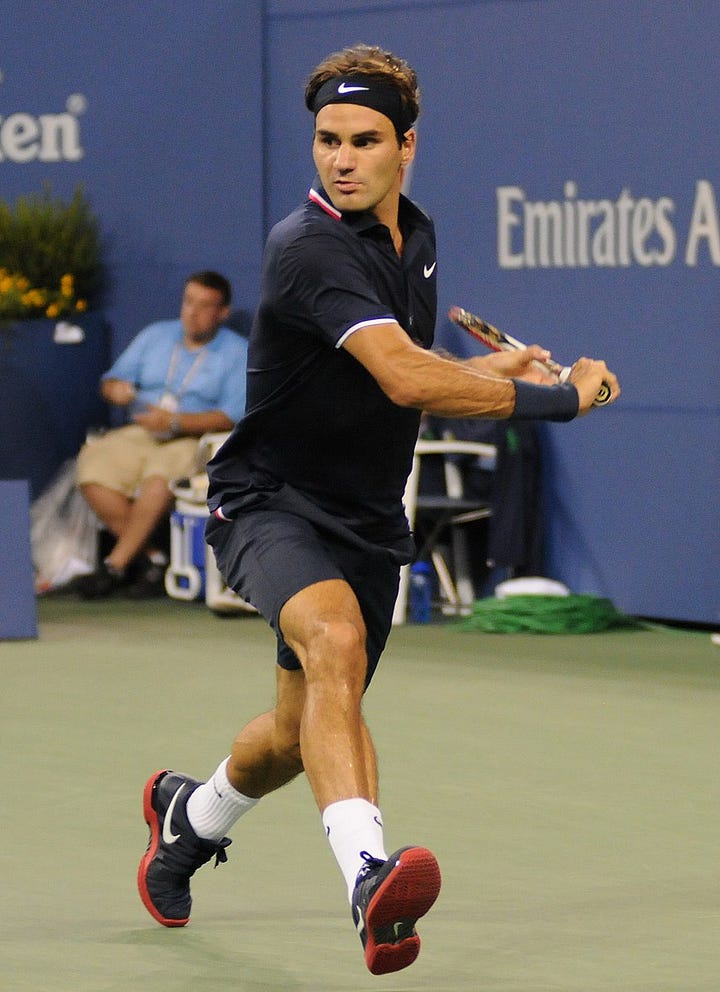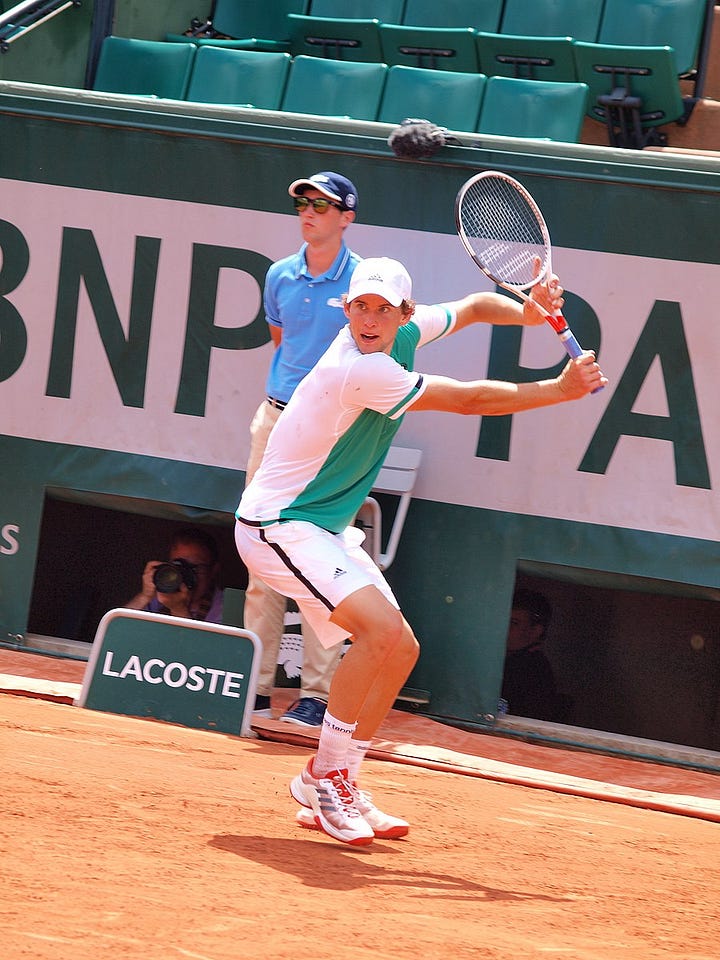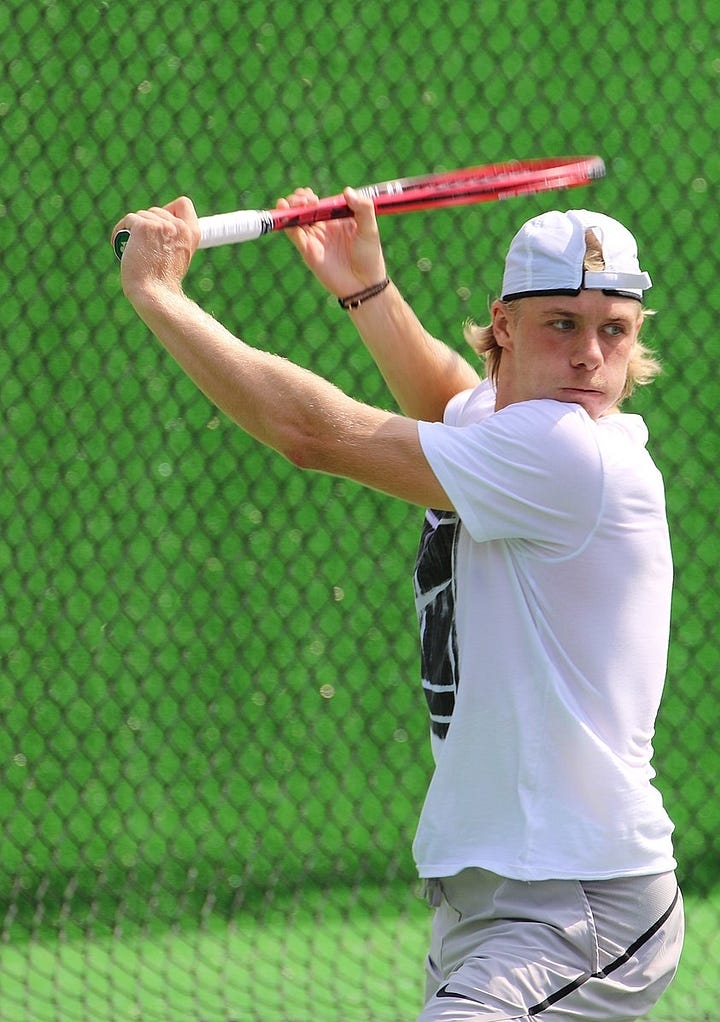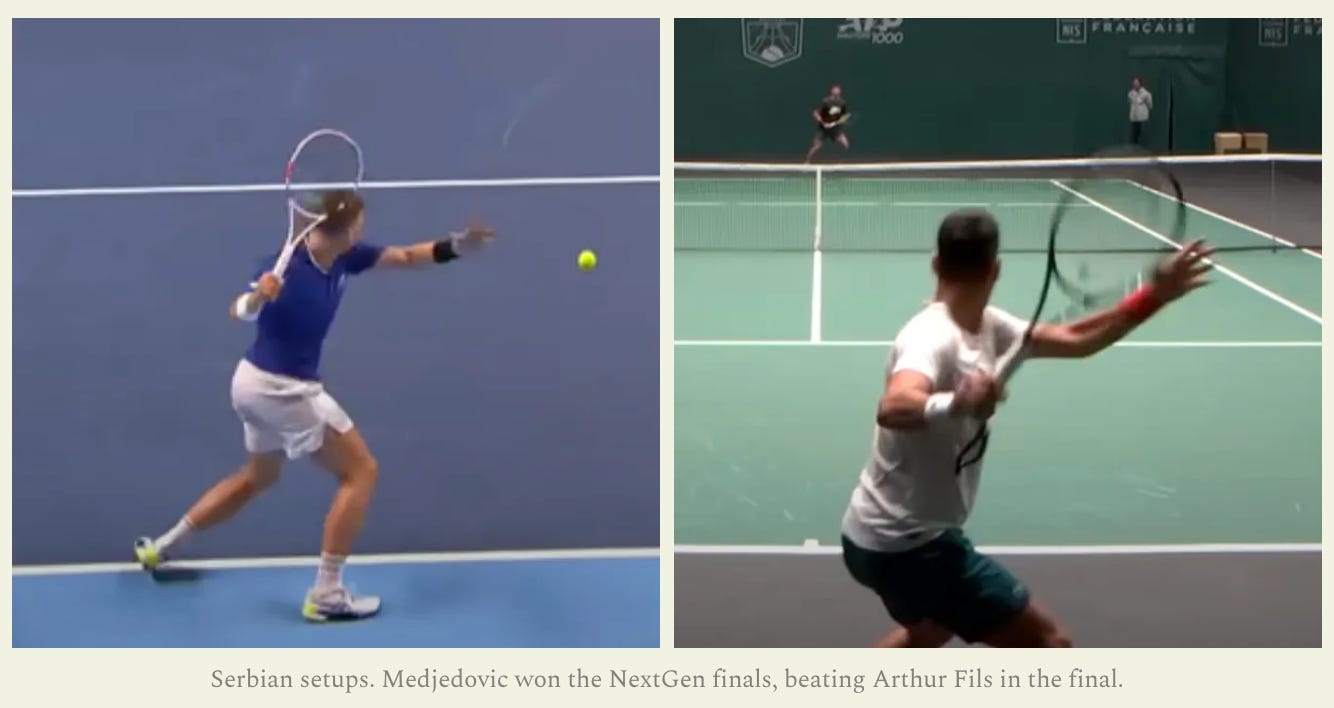February Forehands
Humbert — Medjedovic — Shapovalov — Kecmanovic — Gasquet — Tsitsipas — Bernet
I realise I miss a lot of possible content when I only pick one match a week for a recap, so here’s what else has been on my mind.
February forehands
If we look at the title winners (plus Medjedovic for
) from early February, we can see that all were great performers on the forehand side in 2024, hitting elite numbers on the winners to in-percentage tradeoff. All four men push the upper-right bound of their respective placing from Tennis Insights data.
How they play with their forehands is quite different though, as the chart suggests. Kecmanovic has been one of the most consistent forehands on tour, making over 88% for a 6% winner rate. Humbert is more aggressive at nearly 9% winners, but makes just under 84%. Then we have Shapovalov and Medjedovic, the two biggest hitters in the group, hitting 11% and 12.5% of winners respectively, but not quite making 83% in.
Take a look at how much bigger the backswings of Shapovalov and Medjedovic are compared to the compact takebacks of Humbert and Kecmanovic:

Humbert is one of the most surface sensitive players on tour (he gains around 10 elo points for every percentage increase above the average court speed), and that makes sense when you look at his strokes and gamestyle (and he’s not the best mover).1 He hugs the baseline and has uber-compact swings on both sides. Elbow, hand, and racquet all stay low and on the hitting side. That’s great for absorbing pace and holding your own on the baseline with first-strike tennis in mind (grass, indoors, fast hard), but you can see how this isn’t great on slower courts and clay, where inconsistent and higher bounces renders such compact, baseline-hugging swings as rally fodder for top dogs. This technique is also what I would call ‘tactically inflexible’; his swings are almost too compact to produce the necessary power to play from deep in the court, which is often a great strategy today on clay and with second serves.
Shapovalov has a long swing like Medjedovic, but like many players today he keeps the racquet on the hitting side more Sinner-style. He’s actually a guy who can excel on slower surfaces despite his hardcourt pedigree, as he has the firepower to hit through slow conditions off both wings courtesy of his huge swings. It was positive to see in Dallas recently, however, that Shapo looked to be using the block more effectively. If he developed that into a Wawrinka-esque first-serve return strategy he could be lethal (on a more regular basis; he is a former Wimbledon semifinalist) on quicker stuff.
Kecmanovic is the most consistent forehand performer of the group. I think his ground game is rock solid, he just seems to lack the elite fitness and movement that upper left quadrant of tennis requires. Some of the great players in that section of the forehand chart: Djokovic, Medvedev, Zverev, RBA, de Minaur. All those guys are lean and can play the marathon.
I like Medjedovic’s forehand as a model. It’s reminiscent of Djokovic, a young Thiem, Cerundolo, etc., with the racquet head upright and the wrist extended such that the strings, or hitting side of the racquet, actually faces away from the ball.
Let’s add Fonseca, Sinner*, and Alcaraz to this kind of setup as well.



I am in favour of letting younger players develop longer swings that can create speed and topspin; they often tap into gravity with the racquet head, use their bodies more, and swing more in-to-out (clay also encourages this naturally). In my experience it’s much harder to get a compact hitter to develop length once they are older. But Medjedovic’s is so long, and so big, it’s easy to see him being rushed on this wing in this era (notice how all the others have the racquet/strings on the hitting side of their body, or right side of their head, whereas Hamad has his strings over his left ear. He’s ‘broken the plane’ and that can be trouble).
Medjedovic is not the fittest player (yet), and this can also be a blessing when it comes to forcing players to develop offensive weapons (if you can’t run, you better be able to hit). I made a similar case regarding Kyrgios when covering his 2022 Wimbledon final run here.
We also saw at the Australian Open how offensive Djokovic can be when forced to go on the attack due to injury, and we saw in Doha what Medjedovic could do when he injured his leg against Tsitsipas deep in the third set. Incredibly, he still won the match (playing on one leg, essentially), ripping every ball he could get a hold of in the third set tiebreaker. His forehand is huge. Check out the ending below:
Gasquet’s farewell, and the one-hander
French veteran Richard Gasquet will retire at the French Open this year, having turned professional way back in 2003. Known for one of the greatest single-handed backhands of all time, the Frenchman may not be at the peak of his powers, but he was still putting up elite numbers in 2024 (he made Tennis Insights’ top-10 in 2023), outshining even Djokovic in winners to in-percentage. A look at all the single-handed backhand players from 2024:

A couple of notes:
Evans, Gasquet, Musetti, and Dimitrov are the most consistent of the bunch. I’d wager they are also the ones that would slice the most/have the most effective slice backhands. If Shapo could develop that block return, I think he could work his way up the in-percentage chart without sacrificing his rally-ball offence.
Most of the one-handers are on the higher end of the winner rate chart but the lower end of the in-percentage. That kind of makes sense; you can generate more speed and spin with a one-hander typically, especially when given time to load up, like on clay, but you can also be rushed more and miss returns. It may also be that one-handers are naturally more inclined to develop into aggressive all-court players as well (although Gasquet kind of refutes that; he’s a deep-position counter-puncher at heart, but still rips more than 5% as winners).
I was surprised to see Tsitsipas so far in the weak part of the chart. I figured he wouldn’t be putting up great numbers, but he is by far the worst performing single-hander on this particular metric (with the exception of Eubanks and GMP, which is not surprising given their height). The lack of slice mastery plays into his lower make %, but for a guy who once said his favourite shot was the backhand down the line, he sure isn’t hitting too many by the looks of it, with barely 2.5% of backhands as winners. I’ve never liked the look of the Tsitsipas backhand, although it is fundamentally sound. I’ve always preferred straighter hitting arm structures earlier in the swing (Wawrinka, Thiem, Shapovalov) versus late extenders (Federer, Tsitsipas) for the simple reason that there are fewer moving parts near contact. Thiem’s 2019/2020 backhand showed what was capable in the modern game with a single-hander. Still able to inject huge power and hold his own against the Big-3 on hard courts (his 2019 ATP Finals match vs Djokovic is some all-time hitting if you’ve got 10 minutes.)




What has had me thinking of the single-hander lately was the recent Australian Open boys champion from Switzerland, Henry Bernet. He learned his craft in the same tennis club that Roger Federer trained at as a junior, and his backhand technique looks like it could hold up in the pros. It’s interesting to see how low and straight-back the backswing is, as if the faster meta we are in (high level juniors can crush it) has developed this backhand to work in the modern game. I also like that he gets the arm straight relatively early. It’s like a more abbreviated Thiem backhand. Check out his Australian Open Boys Final highlights:
Keep an eye out for Bernet in the draws this year. I’ll be back after Doha and Rio. See you in the comments. HC.
Humbert is 10th on hardcourts and 26th on clay courts according to Tennis Abstract’s current elo-ratings. He grew up playing on quick indoor hardcourts, and that makes sense. Players are products of their environments more than anything.




Totally missed Bernet winning AO -- it warms my heart to see a young OHBH, and what a beauty it is! Goodness, he looks great. And today I learned that the boys (and I'm sure girls) at AO play let serves.
Since I'm a 3.5 club-level player with a OHBH, it is of course my weak side, but I'm happy to report that it has gotten much more stable now that I keep my arm straight and use my trunk rotation to generate the necessary power. It's only taken me like twenty years to figure this out. ;)
Thank you for this quick piece.
About Tsitsipas, what strikes me most when I see him play is his relative lack of power overall for such a frame with lengthy swings. Even though technique explains plenty about eroding form, it is clear to me that there is also a blatant issue with his character and will. It is further corroborated by his completely dumb social network management that makes him look (in my opinion) like a fool.
I am impressed by the difference of lethality between the 2 groundstrokes : I underestimated the "sword and shield" dichotomy of the groundstrokes. Gasquet whose BH is elite wouldn't be worthy of RBA's forehand, had it been a FH !